Image: Annual greenhouse gas index (1980-2017)

Description: Warming influence of greenhouse gases is increasing The warming influence of greenhouse gases in the atmosphere has increased substantially over the last several decades. In 2019, the Annual Greenhouse Gas Index (AGGI) was 1.45, which represents an increase of 45% since 1990. Carbon dioxide remains the largest contributor to the increase. Radiative forcing (shown on the left vertical axis) is the change in the amount of solar radiation, or energy from the sun, that is trapped by the atmosphere and remains near Earth. When radiative forcing is greater than zero, it has a warming effect; when it is less than zero, it has a cooling effect. In this indicator, radiative forcing from long-lived greenhouse gases is shown relative to the year 1750. AGGI (shown on the right vertical axis) is an index of radiative forcing normalized to the year 1990 (represented by a red dot); it shows that the warming influence of long-lived greenhouse gases in the atmosphere increased by 45% between 1990 and 2019. About Annual Greenhouse Gas Index: This index follows the change in radiative forcing resulting from changing concentrations of twenty long-lived greenhouse gases: carbon dioxide (CO₂) methane (CH₄) nitrous oxide (N₂O) chlorofluorocarbons (CFC-11 and CFC-12) a set of 15 minor, long-lived halogenated gases Radiative forcing of each gas was calculated by the National Oceanic and Atmospheric Administration (NOAA) based on the measured concentrations of each gas in the atmosphere, compared with the concentrations that were present around 1750, before the Industrial Revolution began. Because each gas has a different ability to absorb and emit energy, this indicator converts the changes in greenhouse gas concentrations into a measure of the total radiative forcing (warming effect) caused by each gas. Radiative forcing is calculated in watts per square meter, which represents the size of the energy imbalance in the atmosphere. SOURCE: https://www.globalchange.gov/browse/indicators/indicator-annual-greenhouse-gas-index
Title: Annual greenhouse gas index (1980-2017)
Credit: https://www.globalchange.gov/browse/indicators/indicator-annual-greenhouse-gas-index
Author: National Oceanic and Atmospheric Administration Earth System Research Laboratory
Usage Terms: Public domain
License: Public domain
Attribution Required?: No
Image usage
The following 2 pages link to this image:

